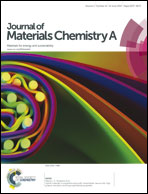Further improvement of battery performance via charge transfer enhanced by solution-based antimony doping into tin dioxide nanofibers†
Abstract
We synthesized antimony (Sb)-doped tin dioxide (SnO2) nanofibers by a one-pot solution doping electrospinning process, and demonstrated that the electrical and lithium (Li)-ion conductivities of SnO2 nanofibers can substantially be increased by such a facile doping process. Owing to improved conductivities, our Sb-doped SnO2 nanofibers exhibited greatly facilitated charge transport features as battery anodes. The current study on the effect of dopant concentration revealed that 10 at.% doping produced optimized electrical and Li-ion conductivities from current–voltage characteristics and Nyquist plots. The Sb-doped SnO2 nanofibers retained over 95% Coulombic efficiency at all variable current rates from a low current rate of 100 mA g−1 to a high current rate of 1000 mA g−1, while pure SnO2 nanofibers had lower Coulombic efficiency values around 85% at the low current rate of 100 mA g−1. Especially, doped nanofibers exhibited a much more stable capacity retention during 100 cycles than undoped SnO2 nanofibers. We herein confirmed that the increase in charge transport properties by the facile solution doping can directly lead to the further improved performance of Li-ion batteries with one-dimensional nanofiber electrodes.


 Please wait while we load your content...
Please wait while we load your content...